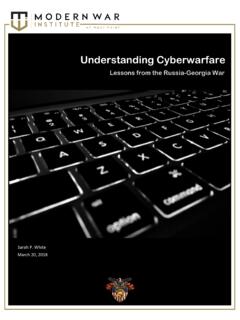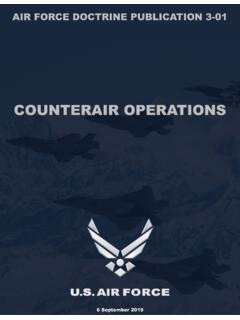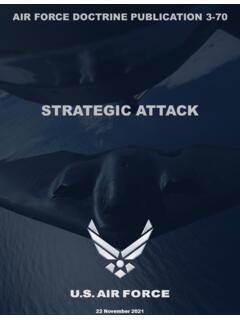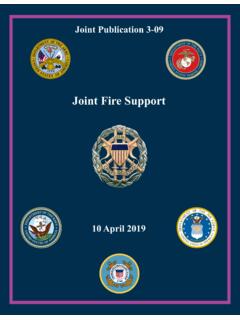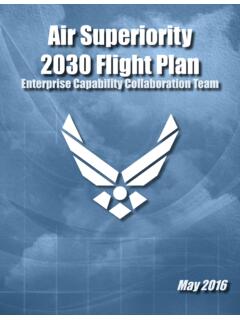Transcription of Modern Urban Operations - Modern War Institute
1 Modern Urban Operations Lessons Learned from Urban Operations from 1980 to the Present Asymmetric Warfare Group November 2016 DISCLAIMER: The information contained herein is not current doctrine or policy and is not meant to supersede doctrine, commander s guidance, or established unit standard operating procedures. Examine and use the information in light of your mission, the operational environment, the Law of Armed Conflict, and other situational factors. This document does not constitute the provision of additional information or the approval of additional information upon request. DISTRIBUTION STATEMENT A: Approved for public release; distribution is unlimited. COPYRIGHT NOTICE: This document may contain copyrighted information. 1 EXCUTIVE SUMMARY Introduction Urban warfare is not a new phenomenon. The Army saw Urban combat in the Revolutionary War, the War of 1812, the Civil War, and elsewhere. Starting with World War II, overall armed conflict began to occur around centers with a high population density.
2 This new backdrop for conflict has caused a whole new set of challenges, especially in an era of public scrutiny. The Army s capacity to engage, fight, and win major Urban combat Operations will determine the success of future operational and strategic endeavors. 1 Purpose To illuminate best practices to execute Urban Operations in Iraq, AWG identified lessons learned from Modern Urban warfare from 1980 to the present. AWG s lens was similar to JFCOM s 2004-06 joint experiment Urban Resolve: How can [the Army] fight in Urban terrain against an intelligent, determined, well-equipped adversary and win quickly without unacceptable casualties to ourselves or our allies, unacceptable civilian casualties, or unacceptable destruction of infrastructure? 2 To that end, AWG looked at the following examples: British Operations in Northern Ireland (1980-98) Israeli Defense Force (IDF) Operations in Lebanon (1982-2006) The Siege of Sarajevo, Bosnia and Herzegovina (1992-95) The Battle of Mogadishu, Somalia (1993) Russian Operations in Grozny, Chechnya, Russia (1994-95 and 1999-2000) Operations in Baghdad and Fallujah, Iraq (2003-04) Lebanese Armed Forces Operations in Nahr al-Bared, Lebanon (May-Sep 2007) The Russo/Georgian War, Georgia (2008) IDF Operations in the West Bank, Israel (2014) The Second Battle of Donetsk, Ukraine (2014-15) Lessons Learned Strategic: Urban Operations are seldom short-lived or Civilian casualties are a major concern in Urban Operations .
3 However, concerns over collateral damage (civilian casualties and property damage/destruction) generally decline as friendly military casualties 1 (Felix, et al. 2015) 2 Ibid. 3 (Marine Corps Intelligence Activity 1999) 4 Ibid. 2 Generally speaking, the side that is less concerned with the safety of the civilian population has the advantage,5 especially if this is coupled with a disregard for reporting the truth and adeptness at manipulating international opinion. Operational: Urban Operations are resource-intensive, specifically requiring large numbers of soldiers and units to effectively clear and hold sections of terrain. Doctrine, tactics, training, and equipment meant specifically for Urban warfare improves military effectiveness in Urban Rules of engagement must be clear given the ambiguous nature of Urban Urban warfare is high-tempo, stressful, and violent, resulting in higher casualties and higher soldier burn-out.
4 8 Bombing and close-air support can support, but not win by itself, Urban airpower (or other standoff, heavy weapons such as artillery) used alone usually requires the complete destruction of Urban areas versus seizing and holding terrain to achieve objectives, but this is often strategically counter-productive. Warfare in an Urban environment necessitates decentralized, small-unit Operations at the tactical level, with junior leaders capable of operating independently using initiative, adaptability, and good judgment. Adversaries will use existing civilian infrastructure such as hospitals, schools, churches, banks, and government buildings because they often are in tactically useful locations, command key terrain or lines of communications, and are solidly Further, many are considered noncombatant or neutral sites which discourage friendly forces from attacking them. Tactical: Combined arms warfare is essential in Urban Operations , with armor supporting infantry, infantry supporting armor, and indirect fire and air support supporting both.
5 Adversaries can leverage the Urban terrain to canalize military forces; negate friendly forces equipment and technology advantages; and engage with multiple weapon systems, such as IEDs, ATGMs, and snipers, from various concealed positions. Adversaries will increasingly use the multi-domain characteristics available in Urban environments, such as subterranean, to mask their Operations and counter friendly forces traditional military advantages. HUMINT is essential to identify adversaries in Urban 5 (Marine Corps Intelligence Activity 1999) 6 Ibid. 7 Ibid. 8 Ibid. 9 Ibid. 10 Ibid. 11 Ibid. 3 Units must adapt for Urban Operations : task organizing as appropriate (including enabler integration), equipping beyond MTOE authorizations, and reducing soldier load to increase mobility and IMPLICATIONS Civilians will be on the Urban battlefield. Commanders must balance operational necessity with minimizing civilian casualties and collateral damage.
6 Urban Operations frequently result in higher casualty rates. Commanders must plan appropriately to mitigate this. However, commanders should not allow casualty rates to reduce attempts to limit civilian casualties. Urban Operations are resource- and Soldier-intensive. Commanders must plan adequate quantities and types of forces to successfully conduct Urban Operations . Because Urban Operations are fast-paced, violent, and stressful, commanders must plan for the relief or replenishment of forces. Urban Operations are a combined arms fight. Commanders should use armor and infantry together. Indirect and air firepower should be used to support ground fighting. Appropriate enablers, such as engineers, should be used to ensure freedom of movement for maneuver forces. Urban Operations are multi-domain. Adversaries will use all aspects of physical and virtual domains to mitigate friendly technological and other advantages. Commanders must do the same. Urban Operations are often a decentralized fight.
7 Small-unit commanders must be resourced and empowered to operate independently based on mission command. Enabling efforts such as information Operations and intelligence are often more than just supporting but instead vital to the success of Urban Operations . Urban Operations do not end upon completion of hostilities. Commanders must plan for post-operation support to the populace, to help ensure a return to normalcy for civilians in the Urban centers. 12 (Marine Corps Intelligence Activity 1999) 4 OPERATION BANNER, NORTHERN IRELAND: 1969-2007 Background The contention that led to the planning and execution of OPERATION BANNER started 300 years earlier with the settlement of Scottish Presbyterians in Ulster Province in Northern Ireland. Although tension between Catholics and Protestants was already well-established, there were no major clashes because they lived in separate communities. Aggression toward British (Protestant) rule began to escalate in the 19th century with the development of the political movement called Sinn Fein and its associated paramilitary branch called the Irish Republican Brotherhood.
8 13 Sinn Fein gained popularity and power but on Easter 1916 was summarily suppressed by the British Army. While Southern Ireland gaining independence in 1922, Northern Ireland remained in the British Empire because the Protestant population retained control despite being the minority. By 1969, the condition of the Catholic population under the Protestant-led government in Northern Ireland had only worsened. In Northern Ireland, Londonderry was the most deprived city in the United Kingdom with the highest unemployment rate of any UK city. Of the 36,000 Catholics in Londonderry, 33,000 lived in slums that were so crowded that families had to sleep in This oppression led to the creation of the Northern Ireland Civil Rights Association (NICRA), which conducted marches and protests to drive social reform in areas such as jobs and While NICRA remained peaceful, their presence caused a strengthening of the loyalists in Northern Ireland. On 5 October 1968, a NICRA march clashed with a loyalist Orange Order march, resulting in a larger riot in Londonderry.
9 Several more clashes occurred over the next year as tensions increased between the Catholic and Protestant populace. The tipping point occurred on 12 August 1969 when a Protestant march collided with a Catholic counter-protest, resulting in violence initially in Londonderry that spread to Belfast and several other cities in Northern Ireland. The Royal Ulster Constabulary (RUC) did not have the manpower or experience to regain control. As a result, the British Army was called in to help suppress the violence, beginning the 38-year-long OPERATION BANNER. Over the course of OPERATION BANNER, the longest in their history, the British Army was tasked with aiding the local police force to manage a hostile population and a resurging terrorist organization, the Irish Republican Army (IRA). Lessons Learned Operational: Friendly militaries must use a sensitive approach to the use of military force, and avoiding over-reaction, from the outset of an emergency deployment.
10 Popular 13 (Operation Banner: An Analysis of Military Operations in Northern Ireland 2006, 2-2) 14 Ibid. 15 Ibid. 5 perceptions will be formed in the first 100 days of a campaign, and they will be critical to military Countering insurgencies, especially in Urban environments, requires vigorous, proactive action across all lines of government activity to address the causes of major unrest as soon as it is apparent, to prevent disorder turning into an insurgency, terrorism, or civil war. This requires not only a pan-government comprehensive approach, but also a single campaign authority so that responses are coordinated Urban Operations require developing first-rate intelligence structures, processes, and capabilities so that military Operations may be intelligence-led and non-military initiatives properly planned and directed. Effectiveness will be judged by what can be gathered and by how well the product is shared and Pre-deployment training, relevant to the environment, is a must.

